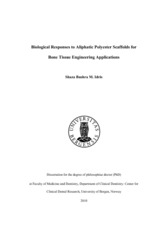| dc.contributor.author | Idris, Shaza Bushra | en_US |
| dc.date.accessioned | 2011-03-17T13:36:41Z | |
| dc.date.available | 2011-03-17T13:36:41Z | |
| dc.date.issued | 2010-12-03 | eng |
| dc.identifier.isbn | 978-82-308-1642-4 (print version) | en_US |
| dc.identifier.uri | https://hdl.handle.net/1956/4590 | |
| dc.description.abstract | Currently, various strategies are used to stimulate healing of bone defects and restore lost alveolar bone and periodontal support. The concept of tissue engineering has emerged as a valid approach to the current therapies for bone regeneration and is attracting considerable attention. Skeletal tissue engineering requires a biocompatible scaffold conducive to cell attachment and maintenance of cell function, in combination with a rich source of osteoprogenitor cells and osteoinductive growth factors. Selection of the most appropriate material to produce a scaffold is an important step towards the construction of a tissue engineered product. Copolymers of Poly(L-lactide)-co-( -caprolactone) [Poly(LLA-co-CL)] and Poly(L-lactide)-co-(1,5- dioxepan-2-one) [Poly(LLA-co-DXO)], with better mechanical properties than the resorbable aliphatic polyester Poly(L-lactide) P[LLA], have recently been developed for application as scaffolds in bone regeneration. The influence of these scaffolds on osteogenic potential is unclear and need to be addressed. Further, little is known about how cells respond at a molecular level to tissue engineered scaffold materials. Thus the overall aims of this series of in vitro studies were to investigate biocompatibility and changes in gene and protein expression profiles caused by these scaffolds and to elicit specific expression profiles and biological pathways at the molecular level. The scaffolds were produced by solvent casting particulate leaching technique. The aim of Study I was to evaluate the biocompatibility of Poly(LLA-co-CL) and Poly(LLA-co-DXO), using the commonly used material, P(LLA) for reference. Scanning electron microscopy and light microscopy showed that the cells had grown and spread well on the test co-polymers. Indirect contact cytotoxicity tests (extraction), performed according to ISO requirements, showed that the test scaffolds are not cytotoxic. The aim of Study II was to assess the growth and differentiation of human osteoblast-like cells (HOBs) seeded onto the two copolymer test scaffolds, Poly (LLA-co-CL) and Poly (LLA-co-DXO) using P(LLA) scaffolding as a control. Cellular response to the scaffold materials was expressed in terms of synthesis of the osteoblast differentiation markers collagen type 1 (Col 1), alkaline phosphatase, bone sialoprotein, osteocalcin (OC), osteopontin and runt related gene 2. Surface analysis disclosed excellent surface attachment and spread of the cells on the test scaffolds compared to the control. Cells grown on the test scaffolds demonstrated higher production of Col 1 and OC and also increased bone marker mRNA expression. Compared to scaffolds of P(LLA), the Poly(LLA-co-CL) and Poly(LLA-co-DXO) scaffolds enhanced attachment and differentiation of HOBs in vitro. Study II clearly showed that the different scaffold materials had influenced genes involved in differentiation of HOBs. Furthermore, a previous study had shown that Poly(LLA-co-DXO) was significantly more hydrophilic than Poly(LLA-co-CL). Based on these findings, selected scaffolds were loaded with HOBs for 24 hours and 21 days for microarray screening of differential gene expression. Therefore, the aim of Study III was to explore and compare the gene expression profiles of HOBs derived from alveolar bone and to find possible biological pathways involved using cells involved in repair of bone defects following culture on Poly(LLA-co-DXO) or P(LLA). For the cells cultured on Poly(LLA-co-DXO) scaffolds, more genes were found to be differentially expressed (up- or down regulated) at 24 hours than at 21 days, when compared with cells cultured on P(LLA). Most of these genes were related to cell adhesion, cell cycle, cell division, cytoskeleton, anti-apoptosis, proliferation and bone mineralization. Three main pathways involving integrin signaling, Notch signaling and Ras Pathway were found. For selected candidate genes, the results were confirmed using quantitative real time reverse transcription polymerase chain reaction. In summary, the results demonstrated that the co-polymers tested in these studies are non-cytotoxic and biocompatible. Compared to scaffolds of P(LLA) and Poly(LLA-co-CL), the Poly(LLA-co-DXO) scaffolds enhanced attachment and differentiation of HOBs in vitro. Microarray analysis disclosed marked differences in global gene expression profiles between HOBs seeded onto Poly(LLA-co-DXO) and P(LLA) scaffolds, especially after 24 hours incubation. Statistical analyses at the chip and probe levels indicated that several genes were differentially expressed as a function of Poly(LLA-co-DXO) scaffolds. Detailed analysis of genes exhibiting differential expression revealed several molecular pathways related to cell adhesion, cell-cell communication and cell proliferation. Therefore, it is concluded that these scaffolds might be appropriate carriers for bone engineering. | en_US |
| dc.language.iso | eng | eng |
| dc.publisher | The University of Bergen | eng |
| dc.relation.haspart | Paper I: Journal of Bioactive and Compatible Polymers 25(6), Idris, S. B.; Dånmark, S.; Finne-Wistrand, A.; Arvidson, K.; Albertsson, A-C.; Bolstad, A. I.; Mustafa, K., Biocompatibility of Polyester Scaffolds with Fibroblasts and Osteoblast-like Cells for Bone Tissue Engineering, pp. 567-583. Copyright 2010 The Author(s). Published by SAGE Publications. Full text not available in BORA due to publisher restrictions. The published version is available at: <a href="http://dx.doi.org/10.1177/0883911510381368" target="_blank">http://dx.doi.org/10.1177/0883911510381368</a> | en_US |
| dc.relation.haspart | Paper II: Journal of Biomedical Materials Research Part A 94A(2), Idris, S. B.; Arvidson, K.; Plikk, P.; Ibrahim, S. O.; Finne-Wistrand, A.; Albertsson, A.-C.; Bolstad, A. I.; Mustafa, K., Polyester copolymer scaffolds enhance expression of bone markers in osteoblast-like cells, pp. 631-639. Copyright 2010 Wiley Periodicals. Full text not available in BORA due to publisher restrictions. The published version is available at: <a href="http://dx.doi.org/10.1002/jbm.a.32726" target="_blank">http://dx.doi.org/10.1002/jbm.a.32726</a> | en_US |
| dc.relation.haspart | Paper III: Idris, S. B.; Bolstad, A. I.; Ibrahim, S. O.; Dånmark, S.; Finne-Wistrand, A.; Albertsson, A.-C.; Arvidson, K.; Mustafa, K., 2010, Global gene expression profile of osteoblast-like cells grown on polyester copolymer scaffolds. Full text not available in BORA. | en_US |
| dc.title | Biological Responses to Aliphatic Polyester Scaffolds for Bone Tissue Engineering Applications | en_US |
| dc.type | Doctoral thesis | |
| dc.rights.holder | Copyright the author. All rights reserved | |
| dc.rights.holder | The author | |
| dc.subject.nsi | VDP::Medical disciplines: 700::Clinical dentistry disciplines: 830 | eng |
